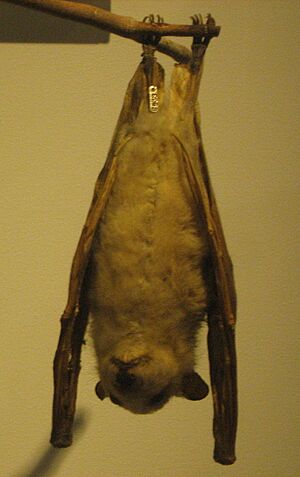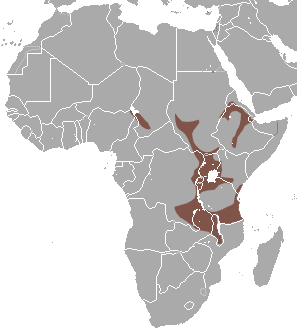Ethiopian epauletted fruit bat facts for kids
Quick facts for kids Ethiopian epauletted fruit bat |
|
|---|---|
 |
|
| Conservation status | |
| Scientific classification | |
| Genus: |
Epomophorus
|
| Species: |
labiatus
|
 |
|
| Ethiopian epauletted fruit bat range | |
| Synonyms | |
|
|
The Ethiopian epauletted fruit bat (Epomophorus labiatus) is a type of large bat. It belongs to the Pteropodidae family, also known as megabats. You can find this bat in many African countries. These include Burundi, Chad, and Ethiopia. It also lives in Kenya, Malawi, and Mozambique. Other homes are Nigeria, Rwanda, Sudan, Tanzania, and Uganda. This bat naturally lives in savanna areas.
Contents
What Does the Ethiopian Epauletted Fruit Bat Look Like?
The Ethiopian epauletted fruit bat is a small bat. It has a pale brown color. On its head, you might see small white spots. These spots are just in front of and behind its ears.
This bat has a long snout. Its ears are small, round, and do not have fur. The fur on its back is thick and soft. It is about 1 cm (0.4 in) long. This fur even goes onto its fore-arms.
Male bats are usually light brown. Each hair has a dark brown base and a lighter brown tip. Their belly fur is lighter, fading to white. Adult males have special white patches on their shoulders. These are called "epaulettes." Usually, you can't see them because they are tucked away in pouches.
Female bats are often smaller and paler than males. Their back fur is a light fawn color. The hairs have beige bases and pale brown tips. Their chest fur is light fawn. Their belly is a bit darker.
Where Do These Bats Live?
This fruit bat lives in parts of Africa south of the Sahara Desert. You can find it in northeastern Nigeria. It also lives in eastern Democratic Republic of the Congo. Other places include Chad and South Sudan.
It ranges eastward to Ethiopia and Eritrea. Southward, it reaches Tanzania. This bat's home areas are spread out. It likes places where rainforest and savanna mix.
It lives in both wet and dry forest areas. This includes mountain habitats in high areas. These are found around the Great Rift Valley. Here, it can live up to about 2,200 m (7,200 ft) high. You might also find it in mangrove forests near the coast.
How Do Ethiopian Epauletted Fruit Bats Live?
These bats mainly eat fruits, like figs. They also munch on leaves. They fly long distances to find different fruit trees. When they move to new feeding spots, they fly fast and straight.
When they are looking for food in the treetops, they fly slowly. They are very good at moving around trees. They can even hover in the air for a short time.
On the ground, these bats move in a clumsy way. Their wings flap, but their back feet don't help much. They can climb along branches. They can also go up and down rough surfaces. They use their thumbs and back feet for this.
Their thumb and second finger can grab things. They use them to skillfully handle their food. During the day, they hang upside down by their back feet. They usually hide in dense plants or under a banana leaf. Several bats might share the same resting spot.
They can hang by their thumbs to go to the bathroom. They use their back feet to comb their fur. They use their long tongue to clean their face and wing membranes.
Conservation Status of the Ethiopian Epauletted Fruit Bat
This bat lives in a large area. It is also a common type of bat. People sometimes hunt it for food. However, it doesn't face many other big dangers.
The total number of these bats is thought to be large. Because of this, the International Union for Conservation of Nature (IUCN) has checked its status. They have listed it as a "least concern" species. This means it is not currently at risk of disappearing.


